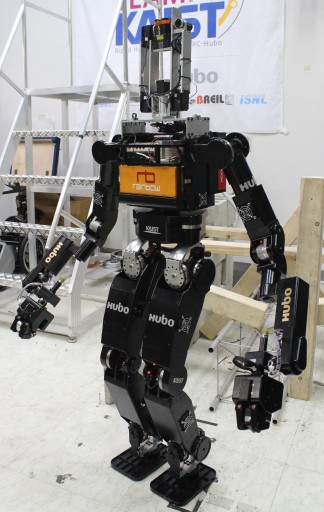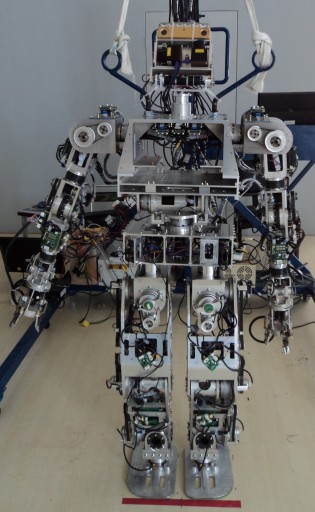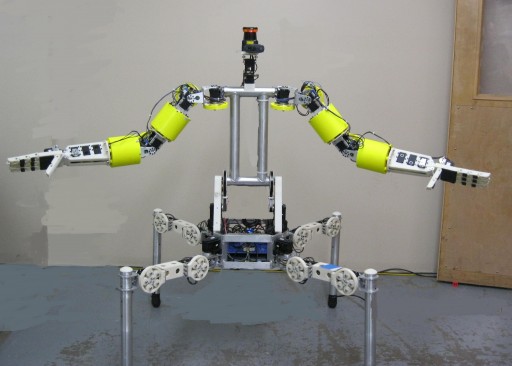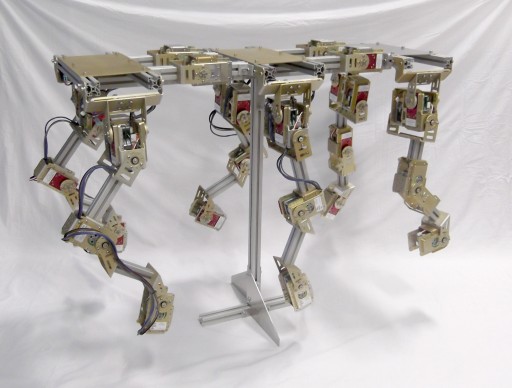Final four teams qualify to participate in DARPA Robotics Challenge Trials
December 11, 2013
[+]

Team KAIST (Daejeon, South Korea) (credit: DARPA)
[+]

Intelligent Pioneer (Changzhou, Jiangshu, China) (credit: DARPA)
[+]

Team Mojavaton (Grand Junction, Colo.) (credit: DARPA)
[+]
Four teams that built full robot hardware and software systems using
their own funds have qualified to join 13 other teams to compete in the Defense Advanced Research Projects Agency (DARPA) Robotics Challenge (DRC) Trials.
Team Chiron (Sandy, Utah) (credit: DARPA)
The event will take place Dec. 20 and 21 at the Homestead-Miami Speedway in Homestead, Fla., where spectators can observe as the robots are tested on the capabilities that would enable them to provide assistance in future natural and man-made disasters.
The new teams are:
- Team Chiron (Kairos Autonomi from Sandy, Utah, USA)
- Team KAIST (Rainbow Co. from Daejeon, Republic of Korea)
- Intelligent Pioneer (Institute of Advanced Manufacturing Technology, Hefei Institute of Physical Science, Chinese Academy of Science from Changzhou, Jiangshu, China)
- Team Mojavaton (Mojavaton LLC from Grand Junction, Colo., USA)
“The DARPA Robotics Challenge was designed to catalyze the robotics community to help mitigate the effects of future disasters, so it is rewarding to see such diverse international participation,” said Gill Pratt, DRC program manager.
“DARPA structured the challenge to encourage participation by experts in hardware and software alike since both fields are necessary to provide a realistic baseline on the current state of robotics.
“The diversity of approaches we expect to see demonstrated at the DRC Trials will mark the beginning of an important transformation in robotics, and these approaches will be further refined going into the DRC Finals in 2014.”
Let the games begin
The new teams join 13 others that will attempt to complete eight physical tasks based on actions a human first responder might have to take in a real disaster situation.
The tasks
will test the human operators and their robots in autonomous
perception, autonomous decision-making, mounted and dismounted mobility,
dexterity, and strength.
During the Fukushima nuclear meltdown, which drove creation of the
DRC, the simple act of turning a valve and venting hydrogen in the
reactor buildings might have prevented catastrophe.However, that single capability is not enough for an effective disaster response robot.
Disasters are unpredictable in their manifestation and effects, so the type of robots DARPA envisions to aid in these situations must be adaptable.
The DRC Trials tasks require robots to demonstrate that they can move from a sanctuary area to a danger zone and then work effectively once there.
All eight of the tasks to be tested are deemed equally necessary.
The DRC Trials are free and open to the public and media. In addition to the competition, the on-site DRC Exposition will showcase technology related to disaster response, robotics and autonomy.
It will include, among others, demonstrations of DARPA’s “Wild Cat” (an untethered, all-terrain version of the “Cheetah” robot) and the Legged Squad Support System. More information can be found at www.theroboticschallenge.org.
(¯`*• Global Source and/or more resources at http://goo.gl/zvSV7 │ www.Future-Observatory.blogspot.com and on LinkeIn Group's "Becoming Aware of the Futures" at http://goo.gl/8qKBbK │ @SciCzar │ Point of Contact: www.linkedin.com/in/AndresAgostini
 Washington
Washington